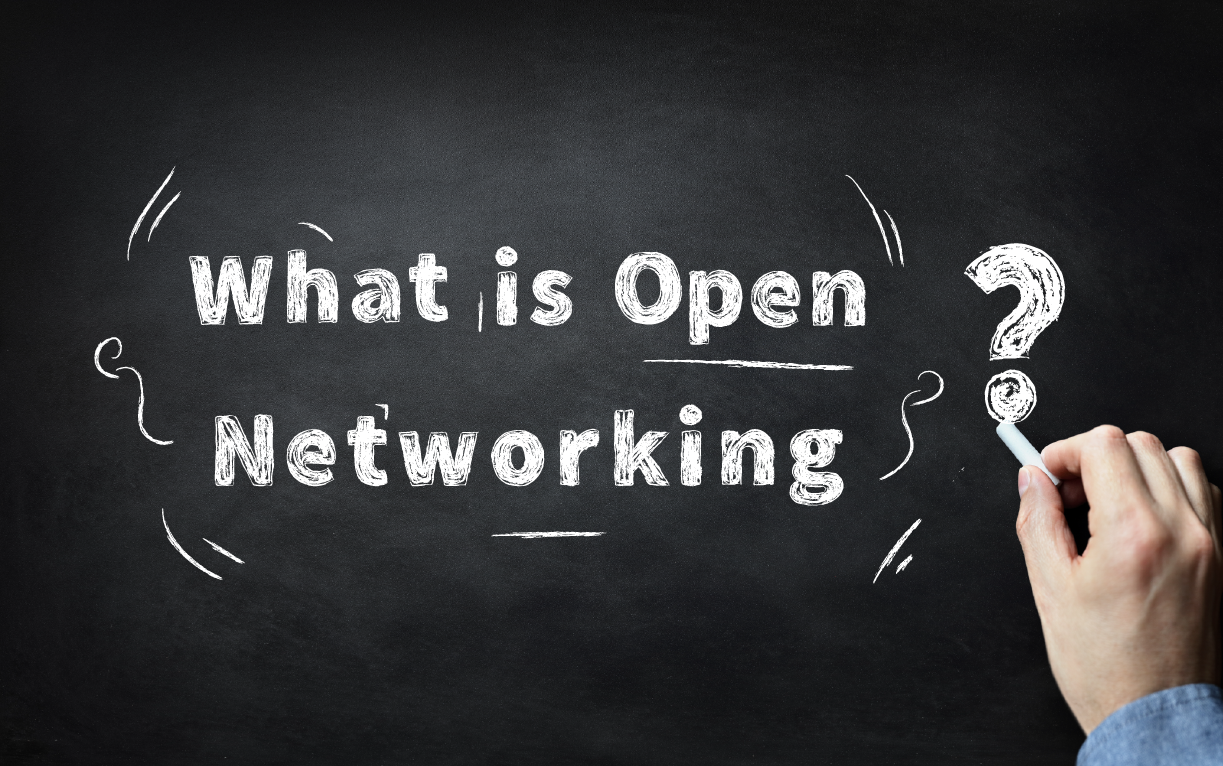What is Open Networking?
Welcome to the world of open networking. If you’ve ever felt constrained by proprietary, closed, and costly network infrastructures, open networking is here to provide you with a breath of fresh air. I will take you on a journey through the definition of open networking, its history, and the current state of open networking in 2023. So, grab a cup of coffee and let’s dive in.
Defining Open Networking
Open networking is a concept that decouples the hardware and software, fostering the utilization of open, standardized, and flexible platforms for building and managing enterprise networks through disaggregation, ultimately offering enhanced adaptability, lower costs, and more customization options. The idea is to break free from the limitations imposed by traditional, closed networking systems by enabling greater control, choice, and innovation. By doing so, open networking allows organizations to design and deploy networks that best suit their unique needs while reducing their total cost of ownership (TCO).
Benefits of Open Networking
Open networking offers a myriad of advantages for organizations seeking to improve their network infrastructure. By leveraging open standards and technologies, companies can achieve better availability, lower total cost of ownership (TCO), increased flexibility and control, and protection against obsolescence.
Better Availability: Global supply chain disruptions and component shortages have made traditional networking products less accessible. Open networking presents an alternative for organizations that need to upgrade or expand their networks while mitigating the impact of these challenges.
Lower TCO: Organizations with limited IT budgets can benefit from open networking’s cost-effective approach, which employs white-box switches, off-the-shelf silicon, and open-source or disaggregated commercial software specifically designed for open networks.
Greater Flexibility & Control: Open networking promotes innovation through collaboration among vendors, giving organizations more options in hardware and software solutions. This increased flexibility allows for the exploration of different networking combinations and the creation of custom solutions using open-source tools.
Protection Against Obsolescence: Disaggregated networking enables organizations to upgrade or replace components individually, without affecting the entire network. This approach allows for the adoption of new technologies without a full network replacement, safeguarding investments beyond the typical 3 to 5 years offered by traditional vendors.
The Current State of Open Networking in 2023
Today, open networking is gaining momentum, and its excitement is palpable. In my 16 years in the enterprise IT business, I have never seen so much enthusiasm for open networking. More and more organizations are looking to adopt open networking solutions to address their pain points, such as long lead times due to supply chain disruptions and high prices exacerbated by inflation. Although open networking has been around for over a decade, the general market is only now on the verge of adoption.
A Brief History of Open Networking
Open networking took its first steps in 2011 when the Open Networking Foundation (ONF) was established by Stanford and Berkeley Universities to pursue Software-Defined Networking (SDN). The community ultimately standardized the OpenFlow protocol, which enabled the separation of the network and control data planes, allowing for multi-vendor SDN. This approach improved network management and monitoring, bringing it closer to how cloud computing operates and laying the foundation for cloud-native SDN technologies.
During this time, terms like white box hardware, disaggregation, and open networking emerged. Cumulus Linux was a pioneer in the open networking revolution, but the market wasn’t quite ready for it in the early years. Cumulus Linux created ONIE (Open Network Install Environment), an open installer boot loader facilitating the Linux environment. In 2013, the Open Compute Project adopted ONIE, which allowed network switch hardware suppliers, distributors, and resellers to manage their operations with fewer hardware SKUs, creating economies of scale in manufacturing and enabling an ecosystem of network hardware and operating system alternatives.
However, Cumulus ultimately didn’t bring about the full-scale revolution it intended and was eventually acquired by NVIDIA. This acquisition led to the loss of access to Broadcom’s SDK, leaving customers with Broadcom-based switches running older versions of Cumulus or purchasing NVIDIA Spectrum switches, the only currently compatible platforms with Cumulus.
As the open networking space evolved, both new and established players entered the scene. Newcomers included NOS vendors like Pica8 and IP Infusion, and orchestration/support/management vendors like Aviz Networks, Beyond Edge, and Hedgehog. Well-known players like NVIDIA, Arista, and Cisco have been involved in open networking since the beginning.
Microsoft initiated the open-source SONiC project, which has attracted contributions from major industry players like Dell, NVIDIA, Arista, Cisco, and Juniper. Hyperscalers like Facebook and Microsoft were the initial creators of the project. The second phase of ONF, which lasted from 2017 to 2021, focused on proof-of-concept and saw tier 1 operators like AT&T and T-Mobile involved in various projects like SMaRT 5G, SD-RAN, SEBA, Volta, and P4. By 2022, ONF platforms were proven viable, and the next goal was to expand adoption and build developer communities for continued growth.
The Open Networking Ecosystem in 2023
Fast forward to 2023, and the open networking ecosystem has grown and matured, with a diverse range of players leading the charge in various areas. Below is a list of some of the top vendors.
Disaggregate Switch and Router Leaders
Let’s delve into the world of disaggregate switch and router leaders, where trailblazing companies like Edge-Core Networks, UfiSpace, NVIDIA, and Arista Networks are revolutionizing open networking solutions and empowering customers with unprecedented control, flexibility, and cost-efficiency in their networks.
Edge-Core
Edge-Core Networks offers open networking solutions built on open hardware and software platforms, providing customers with greater control, choice, and innovation opportunities. By contributing to open-source communities such as OCP, ONF, TIP, DENT, and SONiC, Edge-Core is at the forefront of the open networking movement. This approach lowers the total cost of ownership, stimulates new business models, and empowers customers to achieve their goals. They have recently released their hardened version of enterprise SONiC to which you can add support.
UfiSpace
UfiSpace is more focused on the transport market and is paving the way for the next generation of 5G open network solutions. They are a pioneer in disaggregating and open networking solutions, offering industry-firsts for cell site gateways, core networks, and edge networks. Their focus on high-end networking solutions ensures a commitment to fast time-to-market and state-of-the-art disaggregated open networking platforms. Their platforms are designed to work with the top commercial and open-source NOSes, including ADVA, Arrcus, CapGemini, Exaware, IP Infusion, ONL, and SONiC.
NVIDIA
NVIDIA offers Spectrum switches, which are based on industry-leading application-specific integrated circuit (ASIC) technology, with a wide variety of modern network operating system choices, including NVIDIA Cumulus Linux, SONiC, and Linux Switch. With the acquisition of Cumulus Linux, NVIDIA has made an effort to make Cumulus Linux its flagship NOS. However, it has made some of the most significant contributions to the development of the open-source SONiC NOS. NVIDIA’s flagship products include NVIDIA Air (a digital twin, or a VM, to test drive and validate network operations), their flagship NVIDIA Cumulus Linux NOS, their NVIDIA NetQ network visibility and management toolset, their older NVIDIA Onyx NOS, and NVIDIA Linux Switch which allows you to run pristine Linux as a NOS.
Arista
Arista Networks offer select 7050X and 7060X platforms that are compatible with the open source SONiC that works alongside with Arista EOS NOS. They are designed for high-performance and highly available networks. Arista’s SAI layer allows SONiC to run on Arista switches, leveraging Arista’s advanced hardware design and platform drivers. It enables customers to standardize on open-source software platforms to achieve consistency across their estate while taking advantage of Arista’s core platform development differentiation. Arista SAI offers several key benefits, making it an attractive choice for organizations. By utilizing high-performance platforms from Arista’s market-leading data center portfolio, users can create efficient leaf and spine networks. Operational expenses can be reduced through the integration of DevOps tools, which ensure consistent automation for both compute and networking deployments. Additionally, Arista SAI provides native streaming of deep platform telemetry using OpenConfig APIs. Its high scale and extensive debugging capabilities draw from valuable cloud deployment experience. Moreover, Arista’s world-class services organization offers 24×7 global customer support for SAI and platform-related issues, ensuring a positive end-user experience.
Other disaggregate switches and routers leaders include Celestica, Radisys, and Ragile Networks.
Open Network Operating System (NOS) Leaders
Let’s explore the leaders of Open Network Operating System (NOS) leaders, where groundbreaking NOSes like SONiC, IP Infusion, and Pica8 are shaping the networking landscape with their cutting-edge solutions. By redefining the way networks are managed, these trailblazers offer unparalleled flexibility, scalability, and cost-efficiency in network operations.
SONiC
Software for Open Networking in the Cloud (SONiC) is a Debian Linux-based open-source network operating system (NOS) developed by Microsoft in 2016 and now overseen by the Linux Foundation. Created to address cloud-scale network challenges, SONiC is a multi-layer containerized software providing administrators with greater control and agility. It runs on the Switch Abstraction Interface (SAI) API, ensuring vendor-independent control of forwarding elements. With support for over 100 switch and ASIC vendors, SONiC’s robust ecosystem offers various network management tools for rollout, network visibility, and health checks. Ideal for advanced network architectures, SONiC has top contributors like Broadcom, Cisco, Dell Technologies, Google, Intel, Marvell, Microsoft, and NVIDIA.
IP Infusion
IP Infusion’s Open Compute Network Operating System (OcNOS) is a disaggregated NOS tailored for white box/bare metal infrastructure. Deployed in a variety of use cases, OcNOS simplifies operations, facilitates automation, and provides extensive programmability for comprehensive network management and orchestration. Compatible with a wide range of Open Compute platforms from top-tier vendors, OcNOS ensures consistent operations, automated workflows, high availability, and significantly reduced operational expenses.
IP Infusion recorded a substantial 2X sales increase in 2022 due to robust global demand for open networking solutions. The company finished 2022 with an impressive 90 percent year-over-year (YoY) USD sales growth, fueled by the increasing worldwide demand for its OcNOS networking operating system. The remarkable sales growth can be seen from both new and returning customers, resulting in almost double YoY sales. IP Infusion’s client base expanded with nearly 90 new customer logos and 28 new PartnerInfusion partners joining the company’s network, further solidifying its position as a key player in the open networking solutions market.
Pica8
Pica8 enables businesses to create tailored networks with cost-efficient plug-and-play components and end-to-end automation, reducing the total cost of ownership while enhancing performance, scalability, and flexibility. With over a decade of experience in disaggregated networks, Pica8’s Linux-based open networking tools transform complex networks into secure, easy-to-manage systems. Flagship products, PicOS and AmpCon, empower businesses to control their network infrastructure, delivering a resilient, programmable, and scalable NOS at a lower total cost of ownership while simplifying network automation at scale through a user-friendly interface.
Other leading disaggregate NOS vendors include ADVA Ensemble Activator, Arrcus, CapGemini SDvAS, Cisco IOS XR, DriveNets, Exaware ExaNOS, Infinera CNOS, Vision Edge OS, Netscout Packet Flow Switch, Open Network Linux (ONL) open source foundational platform software, and Rtbrick Full Stack OS.
Orchestration, Support, and Management Leaders
Below are some of the leaders in orchestration, support, and management, who are revolutionizing the networking domain with their comprehensive and innovative solutions. Companies like Aviz Networks, Beyond Edge, and Hedgehog are at the forefront of this transformation.
Aviz Networks
Aviz Networks focuses on deployment and management for SONiC and multi-vendor environments. With a comprehensive suite of tools and services, Aviz Networks enables organizations to quickly and effectively deploy, manage, and maintain their open networking infrastructure. By offering streamlined and scalable solutions, Aviz Networks ensures that organizations can maximize the benefits of their open networking investments.
Beyond Edge
Beyond Edge enables organizations to holistically visualize, manage, and monitor their global multi-vendor LAN through a single pane of glass. By providing a centralized and unified management platform, Beyond Edge simplifies network operations and ensures that organizations can effectively manage and maintain their open networking environments. With advanced analytics, automation, and monitoring capabilities, Beyond Edge empowers organizations to optimize their networks and achieve operational excellence.
Hedgehog
Hedgehog is a startup software company dedicated to giving cloud-native application owners the ability to deploy workloads on edge compute and distributed cloud infrastructure with the same procurement power and automated operations that power the public cloud. By focusing on enabling seamless integration and management of edge computing resources, Hedgehog helps organizations leverage the benefits of cloud-native technologies across distributed and diverse environments. This approach allows businesses to scale efficiently, maintain high levels of performance, and adapt to the rapidly changing demands of modern applications.
Real and Perceived Challenges of Open Networking
As organizations consider adopting open networking, several real and perceived challenges may arise, including choosing between commercial and open-source NOSes, finding appropriate support, and navigating the complexities of the open networking ecosystem.
Choosing Between Commercial and Open-Source NOSes
The decision to opt for a commercial or open-source NOS depends on factors such as the resources and time an organization is willing to invest in setting up and maintaining an open-source NOS like SONiC. However, with the open networking world evolving and SONiC becoming more mature and feature-rich, the appeal of open-source NOSes continues to grow. Companies like Edge-Core and Aviz now offer support for their hardened version of SONiC and vendor-agnostic management tools, respectively, significantly diminishing concerns about support and making open-source NOSes adoption more compelling.
Where Do I Go For Support?
When considering the open networking model, organizations often question the availability of comprehensive support. While traditional vendors provide hardware, software, and support packages, the open networking industry has evolved to address this challenge. Numerous vendors now offer hardware, software, and support bundles with a single point of contact for all support needs. This approach ensures seamless integration and world-class support that rivals traditional vendors’ offerings, making the transition to open networking more accessible and reliable.
How Do I Navigate the Complexities of the Open Networking Ecosystem?
Navigating the ever-growing and changing open networking ecosystem can be a daunting task. Partnering with a company like Hardware Nation, with extensive open networking experience, an in-depth understanding of each vendor, and close relationships with them, can help organizations overcome this challenge. While it is essential to interview vendors and conduct your own research, a vendor-agnostic technology solutions partner can significantly simplify the entire process from discovery to implementation.
The Outlook for Open Networking
In Summary, the interest in open networking has surged in 2022 and 2023, as evidenced by the increasing number of requests for information and proof-of-concept projects that we have been getting. Open networking is now being embraced by organizations of all sizes, proving that it is no longer just for hyperscalers. By providing more control, flexibility, and cost-effectiveness, open networking is poised to revolutionize the way we build and manage networks, and it’s a journey that I, for one, am excited to be a part of.

Alex Cronin, Solutions Architect
Alex is a solutions architect with over 15 years of broad infrastructure experience, specializing in white box networking and open-source infrastructure solutions. He aims to deliver solutions that are impactful, scalable, and cost-effective. Alex is a trusted advisor to organizations and IT leaders, helping them make informed decisions about their IT infrastructure and aligning technology with strategic ambitions.




